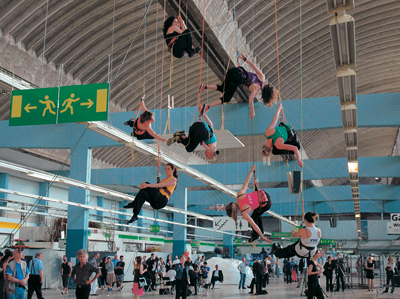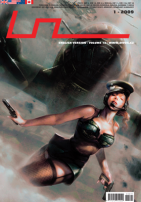| Umělec magazine 2009/1 >> The Active Spacetrategists | List of all editions. | ||||||||||||
|
|||||||||||||
The Active SpacetrategistsUmělec magazine 2009/101.01.2009 Janin Walter | urbanism | en cs de es |
|||||||||||||
|
The SpaceStrategies study concept has evolved very quickly into an interdisciplinary, intercultural group that has succeeded in creating a media opportunity for itself through strategic interventions in Berlin’s urban spaces. The artists within this group – all of them women – have very different backgrounds, interests and attitudes towards the idea of spatial strategies.
Take Maria Luisa Stock; she was born in 1985 in São Paulo, Brazil, where she studied art. Her primary interest is in private living space, where she analyzes the forms of common order, turning them inside out and searching for a reflection of quotidian life: “Living space: this is the space where one lives, what is lived. What is lived is a definite order, a repetition of daily actions. Everyone who lives inside a space develops definite rituals that become material within the objects. What message do these objects convey? The objects do transmit a message; they are charged with stories, memories, dreams.” Regina Weiss and Katinka Theis have defined a different pattern of relations with physical space. Weiss and Theis are German artists who collaborate frequently. In their conception, personal life-projections play a key role in creating a spatial definition, which they describe as a third space: “The third space is the merging of our independently developed artistic starting points: engagement with utopian space-concepts and the question of personal life-patterns that imprint these spaces. Both of these patterns of continuity are tied into the experience of a permanent movement of spatial and social norms, whose historical anchorings and future meanings remain open. In our shared work, we move outwards from the atmosphere of space’s interweaving of relations between the human subject and materiality. What “atmosphere” means in this respect is the daily assumptions of spatial formation in their material aspects and in their internal shiftings, the markings of passing time. Space emerges through the communication of bodies. In the search for the function and meaning of the spatial situations that come about, in our work we expose the interwoven relationships of these component circumstances. With three-dimensional concepts, we accentuate the inexpressible operations of surround-space, in which each participating body is a possible actor.” The conceptions of space employed by the women involved differ based on their artistic backgrounds. Often, space does not even need to be defined as an immediate physical entity. Space can also be the space of imagination, of virtual reality, or even the “fleeting” space that plays a key role for Nathali Fari, also from São Paulo. As a performance artist, she views the performance as precisely this “fleeting space” that must be dragged out of the “White Cube” and into the open. Towards this end, she seeks out such locations as department-store display windows and city squares to make her attitude clear in a highly personal form. Until recently, Leentje van Wirdum, from the Netherlands, worked with virtual space as a graphic designer. Now she is trying to combine virtual and physical spaces, or to force them into confrontation in a continuum of movement. “Because I am fascinated by the operations that my surroundings have on me, what interests me above all is physical space and particularly the interface between culture and nature. The space where the natural and the artificial meet up against each other. Another aspect of space that interests me is the function of transition spaces. How do people move within space, and how can we change or influence through spatial strategies the experience of going?” All of these artists are concerned with art’s function as an object that has an active relationship with its surroundings, as well as its observers. Above all, the idea is to understand art as primarily an “appropriation-experience” —as long as appropriation is not understood in the limiting sense of acquiring property, but in a sense that allows flexibility and transformation. The question of the presentation of felt space – space that works upon something in us and yet simultaneously envelops us – is what interests them. In this search for a presentation, the centralized perspective is becoming obsolete. Consequently, many of the artists search for other media or forms of presentation that make the dependence between image, space and the subject within the space all the clearer, and give the observer the space to find his or her own story. Finding a personal story in the subject could produce the sensation in the observer that the subject is not spatially differentiated from the self – rather, the observer is drawn into the pictures and no longer separates pictures from his or her body to view them. Roos Versteeg, a photographer from the Netherlands, has found in the virtual world’s domination of our daily lives a point of entry that makes our corporeality clearer. “In my latest works, the consciousness of my position has become extremely crucial. In a virtual world, one where space is no longer absolute, all that I can still know is my own position. This awareness leads to a clear apprehension of my surroundings. The viewer can often take up my position as her or his own, or become better aware of it. Often I am myself present, to add life to the work. Afterwards, one can at most take the work home, or have it remain as merely a memory.” Distances also interest another artist regarding the possibilities presented by inserting differing media into a space. Veronica Lehner, a Colombian painter from Bogota, investigates the possibilities of painting within space: “I try, by means of site-specific interventions, events and actions to react to the individual qualities of spaces, to achieve a knowledge of it, to move through the object and its meaning back to the experience of taking it in.” Elinore Burke, an artist from Nashville, Tennessee, USA, places her own body into open spaces as an intervening object. This intervening object could even be called a “parasite in the space,” something that, due to its presence, gives the space a new meaning and makes the observer linger a little longer. Perhaps it is no longer common to spend much time in open spaces, or to spend much time anywhere, for that matter. The commonplace requires a strict sort of attentiveness, one that makes the unnoticed noticeable and the unknown knowable. Attentiveness to the commonplace displaces our apprehension, our focus. Again and again, it brings up the question of how one can make visible that which remains below the surface, and how one can give imbue the meaningless with evident meaning. The object in space, its taking possession of space, and the return to the effects reflects the yearning to create a basic connection to the world on a level beyond merely aesthetic perception.
01.01.2009
Recommended articles
|
|||||||||||||











Comments
There are currently no comments.Add new comment